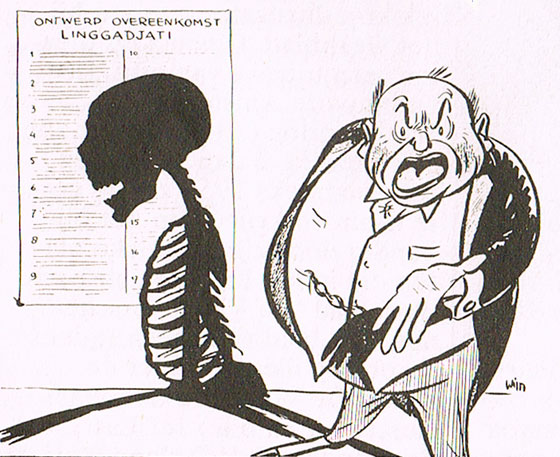Wim van Wieringen was a Dutch cartoonist and photographer, who published under the names "Wim de Mooij", "Wim van Wieringen" or just simply "Wim". He is best remembered for his political caricatures and pantomime gag comic 'Simpelman' (1947-1968).
Early life
Willem de Mooij Wieringen was born in 1915 in Amsterdam, but spent his childhood in many cities, including Nijmegen, Noordwijk, Den Helder, Haarlem and Zandvoort. He had his first job in a linoleum-cliché factory in Haarlem, where he worked on an on-and-off base until 1942. He also made lay-outs for the weeklies published by Strengholt in Amsterdam, while following evening courses by graphic artist Evert Mölenkamp at the School of Applied Arts in Amsterdam between 1932 and 1936.
Cartoon about the Linggadjati Agreement, around 1946.
Cartoons
Van Wieringen turned to cartooning and had his first work published in De Telegraaf (one cartoon in 1936) and De Tijd (a series of caricatures).He found employment with an advertising agency in Heemstede in 1942, and in the following year he became an illustrator with the weekly magazine Cinema en Theater by publisher De Opbouw in Amsterdam. His career as a cartoonist took off after World War II. He gained notoriety through his political drawings for the left-wing socialist weekly De Vlam between 1945 and 1953. A book called '5 Jaar Indonesia Merdeka' was published by the magazine's publisher De Vonk in 1951 and collected mostly drawings by Van Wieringen. He also published his work in De Groene Amsterdammer (drawings from stage play premieres), Het Parool, Het Vrije Volk, Vrij Nederland, Sportief and, most notably, the cartoon monthly Mandril.
Toonder Studio's
Van Wieringen was involved in the underground paper Metro during the first post-war years, which got him affiliated with the Marten Toonder Studios. He worked for the animation department, and wrote scripts for comic series like 'Fiedel Flier' by Ben van 't Klooster and 'Robby' by Hans G. Kresse.
Simpelman
Van Wieringen's best known creation, however, was 'Simpelman', who first appeared in Tom Poes Weekblad in 1947. The absurd daily adventures of 'Simpelman' then appeared in newspapers in Copenhagen (Dagens Nyheter) and Paris (France Soir). During the 1960s the comic strip was a permanent guest in regional papers like Het Parool (1963-1968) and Limburgsch Dagblad. Van Wieringen had already left the Toonder Studios by then. He married Margje Herblot, Jan Gerhard Toonder's former wife. 'Simpelman' was from then on distributed to newspapers by Ton de Zwaan's Swan Features Syndicate. All in all more than 3.000 comics of 'Simpelman' were made.
Final years and death
From 1953 on, Van Wieringen and his wife spent many time traveling, and have lived for longer periods in Santa Margherita Ligure, Italy (1956-1965) and New York (1980s), where he made drawings for the Jewish Week. The couple also wrote articles during their travels, which Van Wieringen illustrated with drawings and photographs. Van Wieringen made political drawings for De Telegraaf in the 1960s, and started a short-lived newspaper strip called 'Joris' for Algemeen Handelsblad in 1961. His final work, an illustrated booklet of his poems, appeared in 1995. On 3 July, 1999, Wim van Wieringen passed away at the age of 83.







